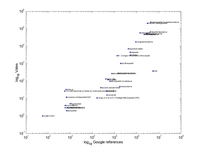September 18, 2006
The Swedish Political Undergrowth
 Yesterday's elections in Sweden were unusually interesting, not just because of the number of major and minor scandals, the uncertainty and the eventual defeat of the social democrats, but also because of the growing interest in the smaller parties. The minor parties got 5.24%, more than twice last election.
Yesterday's elections in Sweden were unusually interesting, not just because of the number of major and minor scandals, the uncertainty and the eventual defeat of the social democrats, but also because of the growing interest in the smaller parties. The minor parties got 5.24%, more than twice last election.
I plotted the number of votes vs the rank of the party, log votes and a log-log diagram (click on picture for a PDF). A few observations:
The 4% cut-off to enter parliament is very visible. Once you are in it is much easier to get attention, and you get party support money. But the same step seems to almost exist between the two largest parties and the rest: once you are a big party you can also set up the system to serve you. There is even a hint that there is something similar happening outside parliament, easiest to see in the single log diagram around Sjukvårdspartiet (the health care party). It might even repeat a few times below that, but now the samples are getting small. But it doesn't strike me as strange that there would be stratification among the minor parties. Sverigedemokraterna, Piratpartiet, Feministiskt Initiativ and Junilistan were mentioned and discussed in the media, most of the others were not.
 In fact, if we plot log votes vs log number of references on Swedish web pages we get a pretty good linear fit.
In fact, if we plot log votes vs log number of references on Swedish web pages we get a pretty good linear fit.
Enhet ("unity"), being a single and relatively common word, gets a lot more hits than it should. It is interesting to note that the retiree party SPI gets unusually few google hits - maybe the members are less keen on computers? There is also a clear gap or break between the 10,000+ reference parties and the smaller ones of an order of magnitude. The feminist party and piracy party were surprisingly weakly represented on the net - I would have expected them to be far more referenced. Now they just follow the line.
The single log diagram shows that voting numbers could be fitted with a simple exponential (votes for party N = 10^(5.3425-0.1645 N)), which correctly predicts 32-33 parties with more than one vote. But as the loglog diagram shows, one could fit a power law to the smaller parties and maybe the larger one, with a break at 4%. The lesson is that with data that doesn't stretch across decades it is hard to distinguish different distributions.
Overall, I'm most impressed by the piracy party. In my opinion they have a very flawed ideology and no political experience whatsoever. Yet they managed to get more than half of the votes of the feminist party, led by an experienced and well-known political leader. And they beat Junilistan, who last election did a surprise run at the EU poll. My theory is that they got both the youth and a number of the high tech votes - a voting group that none of the other parties have done anything to attract. It is very likely that the party will continue to have an influence on the Swedish IP debate.
The party I missed in this data was the Donald Duck Party, which has declined since 1991 (1500 votes) to just 10 last election and apparently none this one. But then again, I once voted for the Ezenhemmer Plastic Bags and Child Rearing Utensils Party, mostly since they had promised to make me Minister of Science if they won. In fact, there seems to be a lack of frivolous parties in the data right now. Maybe people are indeed taking politics too seriously.
ADDENDUM: I just noticed a list of parties with only handwritten notes. So the Donald Duck Party did not vanish, it just got 8 votes (plus some alternate spellings). And it seems that it is down here among the one-vote parties we find the old joke parties. As well as Ny Demokrati, which always was a joke.
Posted by Anders3 at September 18, 2006 07:51 PM